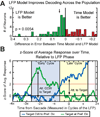Serial, covert shifts of attention during visual search are reflected by the frontal eye fields and correlated with population oscillations
- PMID: 19679077
- PMCID: PMC2758537
- DOI: 10.1016/j.neuron.2009.06.020
Serial, covert shifts of attention during visual search are reflected by the frontal eye fields and correlated with population oscillations
Abstract
Attention regulates the flood of sensory information into a manageable stream, and so understanding how attention is controlled is central to understanding cognition. Competing theories suggest visual search involves serial and/or parallel allocation of attention, but there is little direct, neural evidence for either mechanism. Two monkeys were trained to covertly search an array for a target stimulus under visual search (endogenous) and pop-out (exogenous) conditions. Here, we present neural evidence in the frontal eye fields (FEF) for serial, covert shifts of attention during search but not pop-out. Furthermore, attention shifts reflected in FEF spiking activity were correlated with 18-34 Hz oscillations in the local field potential, suggesting a "clocking" signal. This provides direct neural evidence that primates can spontaneously adopt a serial search strategy and that these serial covert shifts of attention are directed by the FEF. It also suggests that neuron population oscillations may regulate the timing of cognitive processing.
Figures





Similar articles
-
Frontal eye field activity enhances object identification during covert visual search.J Neurophysiol. 2009 Dec;102(6):3656-72. doi: 10.1152/jn.00750.2009. Epub 2009 Oct 14. J Neurophysiol. 2009. PMID: 19828723 Free PMC article.
-
Frontal eye field microstimulation induces task-dependent gamma oscillations in the lateral intraparietal area.J Neurophysiol. 2012 Sep;108(5):1392-402. doi: 10.1152/jn.00323.2012. Epub 2012 Jun 6. J Neurophysiol. 2012. PMID: 22673327 Free PMC article.
-
Neuronal basis of covert spatial attention in the frontal eye field.J Neurosci. 2005 Oct 12;25(41):9479-87. doi: 10.1523/JNEUROSCI.0741-05.2005. J Neurosci. 2005. PMID: 16221858 Free PMC article.
-
Neural chronometry and coherency across speed-accuracy demands reveal lack of homomorphism between computational and neural mechanisms of evidence accumulation.Philos Trans R Soc Lond B Biol Sci. 2013 Sep 9;368(1628):20130071. doi: 10.1098/rstb.2013.0071. Print 2013 Oct 19. Philos Trans R Soc Lond B Biol Sci. 2013. PMID: 24018731 Free PMC article. Review.
-
The resurrection of Tweedledum and Tweedledee: bimodality cannot distinguish serial and parallel processes.Psychon Bull Rev. 2014 Oct;21(5):1165-73. doi: 10.3758/s13423-014-0599-0. Psychon Bull Rev. 2014. PMID: 24614966 Review.
Cited by
-
Prefrontal neurons of opposite spatial preference display distinct target selection dynamics.J Neurosci. 2013 May 29;33(22):9520-9. doi: 10.1523/JNEUROSCI.5156-12.2013. J Neurosci. 2013. PMID: 23719818 Free PMC article.
-
Cortical Neural Computation by Discrete Results Hypothesis.Front Neural Circuits. 2016 Oct 19;10:81. doi: 10.3389/fncir.2016.00081. eCollection 2016. Front Neural Circuits. 2016. PMID: 27807408 Free PMC article. Review.
-
Transcranial magnetic stimulation to frontal but not occipital cortex disrupts endogenous attention.Proc Natl Acad Sci U S A. 2023 Mar 7;120(10):e2219635120. doi: 10.1073/pnas.2219635120. Epub 2023 Feb 28. Proc Natl Acad Sci U S A. 2023. PMID: 36853947 Free PMC article.
-
Contribution of FEF to Attentional Periodicity during Visual Search: A TMS Study.eNeuro. 2019 Jun 24;6(3):ENEURO.0357-18.2019. doi: 10.1523/ENEURO.0357-18.2019. Print 2019 May/Jun. eNeuro. 2019. PMID: 31175148 Free PMC article.
-
Causal Evidence for the Role of Neuronal Oscillations in Top-Down and Bottom-Up Attention.J Cogn Neurosci. 2019 May;31(5):768-779. doi: 10.1162/jocn_a_01376. Epub 2019 Feb 6. J Cogn Neurosci. 2019. PMID: 30726180 Free PMC article.
References
-
- Barcelo F, Suwazono S, Knight RT. Prefrontal modulation of visual processing in humans. Nat Neurosci. 2000;3:399–403. - PubMed
-
- Bichot NP, Rossi AF, Desimone R. Parallel and serial neural mechanisms for visual search in macaque area V4. Science. 2005;308:529–534. - PubMed
-
- Bichot NP, Schall JD. Effects of similarity and history on neural mechanisms of visual selection. Nat Neurosci. 1999;2:549–554. - PubMed
-
- Bisley JW, Goldberg ME. Neuronal Activity in the Lateral Intraparietal Area and Spatial Attention. Science. 2003;299:81–86. - PubMed
Publication types
MeSH terms
Grants and funding
LinkOut - more resources
Full Text Sources
Other Literature Sources

